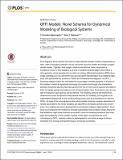OFFl Models: Novel Schema for Dynamical Modeling of Biological Systems
Author(s)
Ogbunugafor, C. Brandon; Robinson, Sean Patrick
DownloadOgbunugafor-2016-OFFl Models_ Novel S.pdf (513.4Kb)
PUBLISHER_CC
Publisher with Creative Commons License
Creative Commons Attribution
Terms of use
Metadata
Show full item recordAbstract
Flow diagrams are a common tool used to help build and interpret models of dynamical systems, often in biological contexts such as consumer-resource models and similar compartmental models. Typically, their usage is intuitive and informal. Here, we present a formalized version of flow diagrams as a kind of weighted directed graph which follow a strict grammar, which translate into a system of ordinary differential equations (ODEs) by a single unambiguous rule, and which have an equivalent representation as a relational database. (We abbreviate this schema of “ODEs and formalized flow diagrams” as OFFL.) Drawing a diagram within this strict grammar encourages a mental discipline on the part of the modeler in which all dynamical processes of a system are thought of as interactions between dynamical species that draw parcels from one or more source species and deposit them into target species according to a set of transformation rules. From these rules, the net rate of change for each species can be derived. The modeling schema can therefore be understood as both an epistemic and practical heuristic for modeling, serving both as an organizational framework for the model building process and as a mechanism for deriving ODEs. All steps of the schema beyond the initial scientific (intuitive, creative) abstraction of natural observations into model variables are algorithmic and easily carried out by a computer, thus enabling the future development of a dedicated software implementation. Such tools would empower the modeler to consider significantly more complex models than practical limitations might have otherwise proscribed, since the modeling framework itself manages that complexity on the modeler’s behalf. In this report, we describe the chief motivations for OFFL, carefully outline its implementation, and utilize a range of classic examples from ecology and epidemiology to showcase its features.
Date issued
2016-06Department
Massachusetts Institute of Technology. Department of Earth, Atmospheric, and Planetary Sciences; Massachusetts Institute of Technology. Department of PhysicsJournal
PLOS ONE
Publisher
Public Library of Science
Citation
Ogbunugafor, C. Brandon, and Sean P. Robinson. “OFFl Models: Novel Schema for Dynamical Modeling of Biological Systems.” Edited by William W Lytton. PLoS ONE 11, no. 6 (June 7, 2016): e0156844.
Version: Final published version
ISSN
1932-6203